051716_YKBP_A4.pdf












4 Broadcaster Press
May 17, 2016 www.broadcasteronline.com
To all those whose office
phone number is 9-1-1,
thank you,
Vermillion Fire EMS Department
National EMS Week
May 15 - 21, 2016
Vermillion Fire EMS Department Steps Up Their Game
By Sarah Wetzel
For the Plain Talk
The Vermillion Fire EMS
Department is running
a tight ship despite a
constant rise in calls
according to Matt Callahan, Division Chief
in charge of EMS operations. Callahan has
been in the position for
a little over a year and
has been proud of how
things have run in Vermillion. “Last year was a
busy year,” he said. “We
ran 920 calls ambulances were dispatched
to. We’re seeing an
increase of about seven
percent yearly. That’s
going to continuously go
up. People are getting
older. Baby boomers
are getting up there in
age. People are also
waiting longer to seek
medical treatment with
the insurance changes
now. So our call volume
tends to go up due to
that.”
Improvements have
been made during the
year according to Callahan such as advances
and replacing equipment. “We’re trying to
fine-tune and get best
practice and provide the
best possible care in the
shortest amount of time
and get patients to the
hospital or emergency
room,” he said. The department staff currently
stands at 23 and growing in number and skill.
“We have some people
who are currently looking to go to paramedic
school and some who
are going to take the
advanced EMT course
so we’d be able to
provide more advanced
care,” Callahan said.
“Those schools take
anywhere from six to
18 months to complete.
Our staff is comprised
of 50 percent university
students, both fire and
EMS. We excel and succeed with the university
students even though
we only have them for
three or four years and
then they’re gone but
we constantly have new
people applying. We
train monthly and they
get a solid training and
they see quite a bit of
call volume then they go
on and hopefully they’ll
join a volunteer organization.”
It seems as if the
Vermillion community
itself is doing well with
emergency preparation.
“The Vermillion community CPR program which
is put on by the Vermillion/Clay County EMS
Association & Sanford
Health Vermillion is
going strong,” Callahan
said. “They had one of
their biggest years ever
last year and certified
almost 500 people in
the community and the
and pay online,” Callahan said. “In this day
and age people very
rarely carry cash or
have checks so it gives
people the ability to
pay with a debit card
or credit card online. If
people want to register
the old way they can
always call the station here and we’ll get
them registered.”
This week comes
as a reminder for the
country as a whole to
recognize the service
provided by EMS departments nationwide.
“Every year there’s a
week that’s designated
as National EMS week,”
Callahan said. “That was
started by President
MATTHEW CALLAHAN, Ford in 1974. This year it
EMS CHIEF
is May 15-21.” Since the
surrounding area in
Vermillion Fire and EMS
CPR. They do classes
departments are commonthly that are prebined they choose to do
scheduled plus they
one large open house in
do a lot of on-request
October for Fire Prevenclasses for businesses
tion Week though many
and the university. A lot
cities will do proclamaof the medical students
tions and the like for
come through us to get
National EMS week. “It
their CPR certification.”
is nice,” Callahan said.
All dates and other
“Our staff doesn’t get
details for CPR trainthe recognition a lot
ing can be found on the
of times and the thank
city website under the
yous. It’s the least of
EMS tab. “They started
our worries when we’re
a new thing this year in
transporting somebody.
January where you can
When President Ford
actually register online
started doing this it was
a really good thing. It’s
just a yearly reminder
that these people are
out in the community
and they’re there to assist and help.”
Callahan is determined
to continue improving
the excellent service
the department has
provided to the Vermillion community. “When I
came here it was a solid
department, thriving to
excel and we’ve done
that,” he said. “We’re
continuing to grow
and become better. We
become better at our
jobs every day through
training and call review
and stuff like that. We
have a fantastic staff
and they do a fantastic
job at what they do.”
Training hours
depend on the license
each staff member
holds with paramedics required to earn 60
hours every two years
with EMT’s 40 hours.
“They have to attend
certain topic areas, it
can’t be all on one area,”
Callahan said. “There’s
a guideline on how it
needs to be split up.”
Callahan hopes that the
community realizes the
time and dedication the
Fire EMS staff spend on
their service. “We’re
here 24/7,” he said. “The
staff is all paid on call.
We staff two ambulances
on the clock so there’s
a lot of time and dedication that goes in by
these folks to being on
call and taking calls.”
On average calls
come in about three
times a day though it
varies widely. “Some
days we may run 7-8
calls, other days we
might run zero calls,”
Callahan said. “It all
balances out in the end.
We have a lot of employers in town that let
people leave to come to
ambulance calls which
is fantastic. If we didn’t
have the student body
and all the employes
working together to allow people to leave and
come to calls it would
be very hard to operate
a department as large
as ours.” According to
Callahan the best part
about the job is knowing he can help people
make a difference.
“When we see people,
both the fire and ambulance side, it’s really the
worst day of their lives,”
he said. “It’s up to us to
come in and help them
pick up the pieces and
help them get better and
get to definitive care.”
9 Heart Attack Symptoms and Early Warning Signs
What are symptoms of
a heart attack? Knowing
the early warning signs of
heart attack is critical for
prompt recognition and
treatment. Many heart
attacks start slowly, unlike
the dramatic portrayal
often seen in the movies.
A person experiencing a
heart attack may not even
be sure of what is happening. Heart attack symptoms vary among individuals, and even a person
who has had a previous
heart attack may have
different symptoms in a
subsequent heart attack.
Although chest pain or
pressure is the most common symptom of a heart
attack, heart attack victims may experience a diversity of symptoms. The
following list describes the
symptoms of heart attack
in more detail.
1. Chest discomfort. Manifest as pain, fullness, and/
or squeezing sensation of
the chest. Chest pain is
the hallmark symptom of
a heart attack, although
it can take many different forms. In other cases,
chest pain may not occur
at all. The characteristic
chest pain of a heart attack has been described
as a sense of pressure,
squeezing, fullness, or
pain that starts in the
center of the chest. The
pain or discomfort typically lasts more than a few
minutes, or it may go away
and then return. It can
spread down the arms, to
the back, or to the head
and neck. Both women
and men report chest pain
as a primary symptom of
heart attack, but women
more often than men are
likely to have some of the
other symptoms, such as
nausea, jaw pain, or shortness of breath, that are
described below.
2. Jaw pain, toothache,
headache. The pain of a
heart attack can spread
Latte Da
Mon - Thurs: 6:30AM - 7PM
Friday: 6:30AM - 5PM
Saturday: 7AM - 2PM
Most Sundays: 8AM - 11AM
709 E. Cherry Street • Vermillion
624•6306
We
Deliver!
Thank You All
EMS & Fire Service Personnel
down both arms, to the
jaw or head, or to the
back. Some people report
tooth pain or headache
as a symptom of a heart
attack. It is possible to
have these types of pain
without chest pain during
a heart attack.
3. Shortness of breath.
Feeling short of breath or
like you are gasping for air
is a common symptom of
a heart attack. Shortness
or breath, or difficulty
breathing, is medically
known as dyspnea. Shortness of breath may occur
before or during the chest
pain of a heart attack,
and in some cases, it may
be associated with other
heart attack symptoms
without any chest pain.
4. Nausea or feeling sick
to your stomach. It’s a
less common but possible
symptom of heart attack.
Sometimes belching or
burping can accompany
the nausea, and some
patients have described
a feeling like indigestion
associated with a heart
attack. Women are more
likely than men to report
these less typical symptoms of heart attack, and
some patients have described feeling as though
they are developing the
flu.
5. Vomiting. The nausea
that accompanies a heart
attack can become so severe that vomiting occurs.
6. General epigastric
(upper middle abdomen)
discomfort. Sometimes
the pain of heart attack
is described as stomach
pain, or pain in the middle
of the upper abdomen.
The pain usually feels
more like discomfort of
heaviness srather than
sharp, stabbing pain, and
the pain tends to persist
more than a few minutes.
This can occur with or
without pain in the true
chest area.
7. No symptoms. Approximately one quarter of all
heart attacks are silent,
without chest pain or new
symptoms and silent heart
attacks are especially common among patients with
diabetes mellitus). Even
though the symptoms of a
heart attack at times can
be vague and mild, it is important to remember that
heart attacks producing
no symptoms or only mild
symptoms can be just as
serious and life-threatening
as heart attacks that cause
severe chest pain. Too
often patients attribute
heart attack symptoms to
"anxiety," "indigestion,"
"fatigue," or "stress," and
consequently delay seeking
prompt medical attention.
One cannot overemphasize
the importance of seeking
prompt medical attention
in the presence of symptoms that suggest a heart
attack. Early diagnosis and
treatment saves lives, and
delays in reaching medical
assistance can be fatal. A
delay in treatment can lead
to permanently reduced
function of the heart due to
more extensive damage to
the heart muscle.
8. Arm pain (more commonly the left arm, but
may be either arm). The
chest pain of a heart attack
can spread, or radiate,
down one or both arms
and to the shoulders. This
often happens, and the
pain may even extend to
the wrist and fingers. This
is most common on the
left side of the body but it
can also occur on the right
side.
9. Upper back pain. The
upper back is another common location for spread
of the pain from a heart
attack. Most commonly,
back pain that stems from
a heart attack is described
as occurring between the
shoulder blades.
n Metro Creative Connections
Proud supporters
of all Vermillion
EMS and Fire
Personnel!
EMS and FIRE
www.pressingmatters.biz
Thank You
217 W. Kidder St. • Vermillion, SD • (605)624-3741
Thank you EMS & Fire
for all that you do!
Bunyan’s
Bar and Grill
1201 W Main • Vermillion
605.624.9971
113 W. Main St. • Vermillion • 624-2655
Thank you
EMS and Fire!
Just What the
Doctor Ordered!
5 W Cherry St • Vermillion, SD • 624-4444
E
M
S
Thank You
EMS and Fire!
A special Thank You to all the Clay County EMS
& Fire personnel for all that you do!
Thank you to all our
local EMS and Fire
responders.
We appreciate what you
do for our community!
& Formal Wear
Thank You
EMS and Fire!
201 W. Cherry St. • 624-4429
Yesterday • Today
Tomorrow
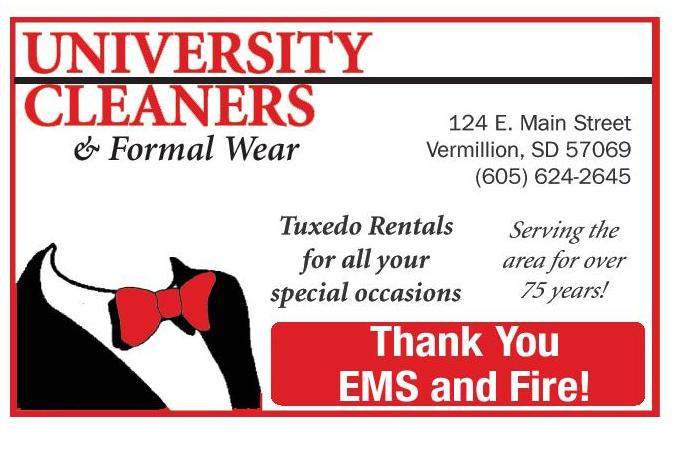
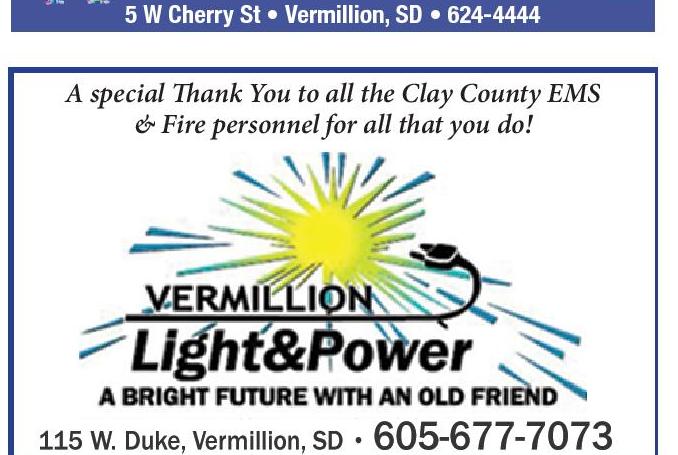
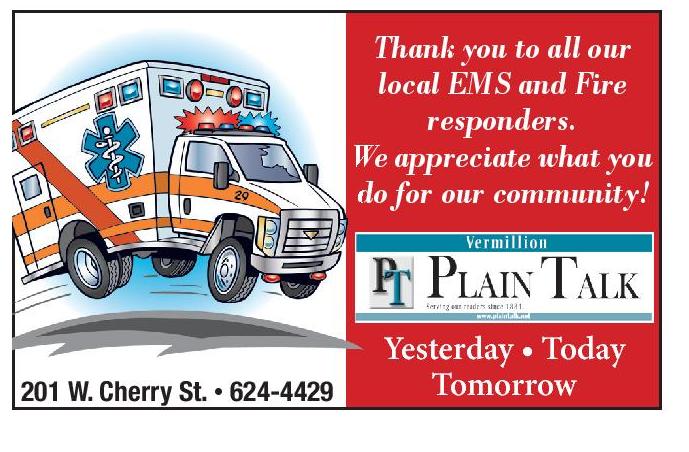
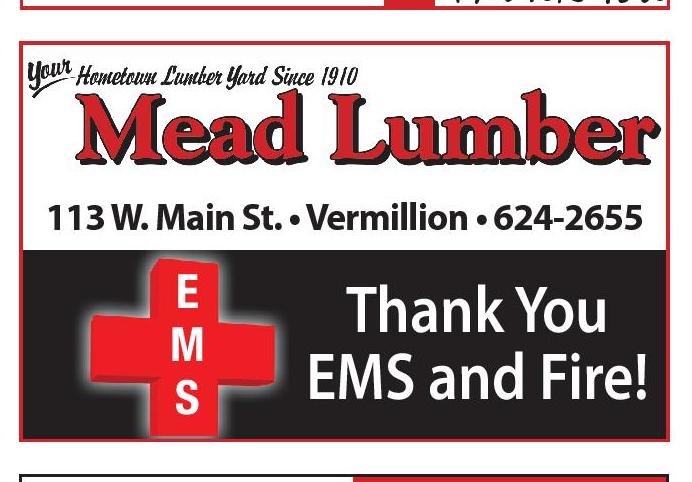

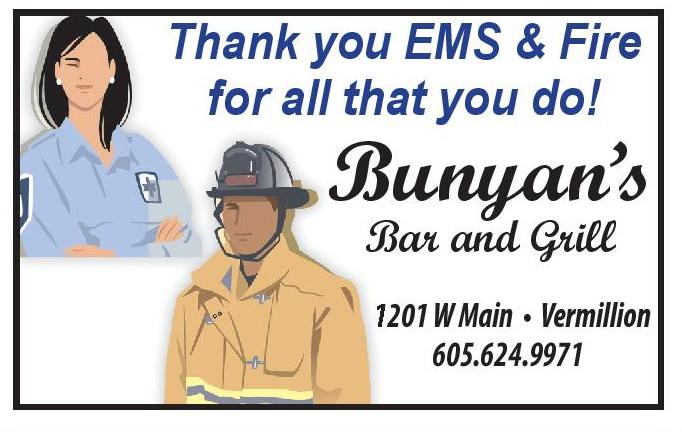
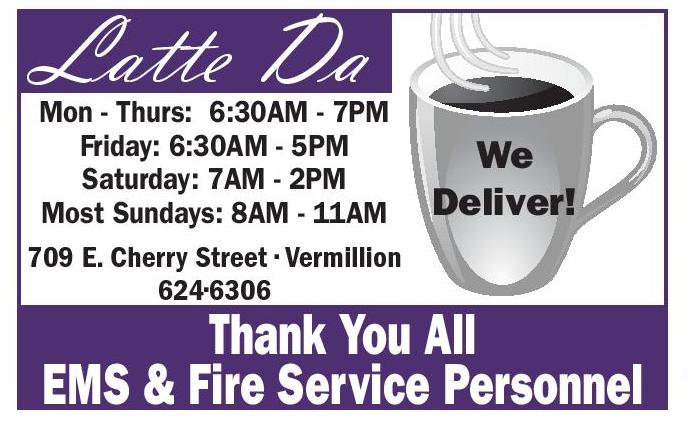



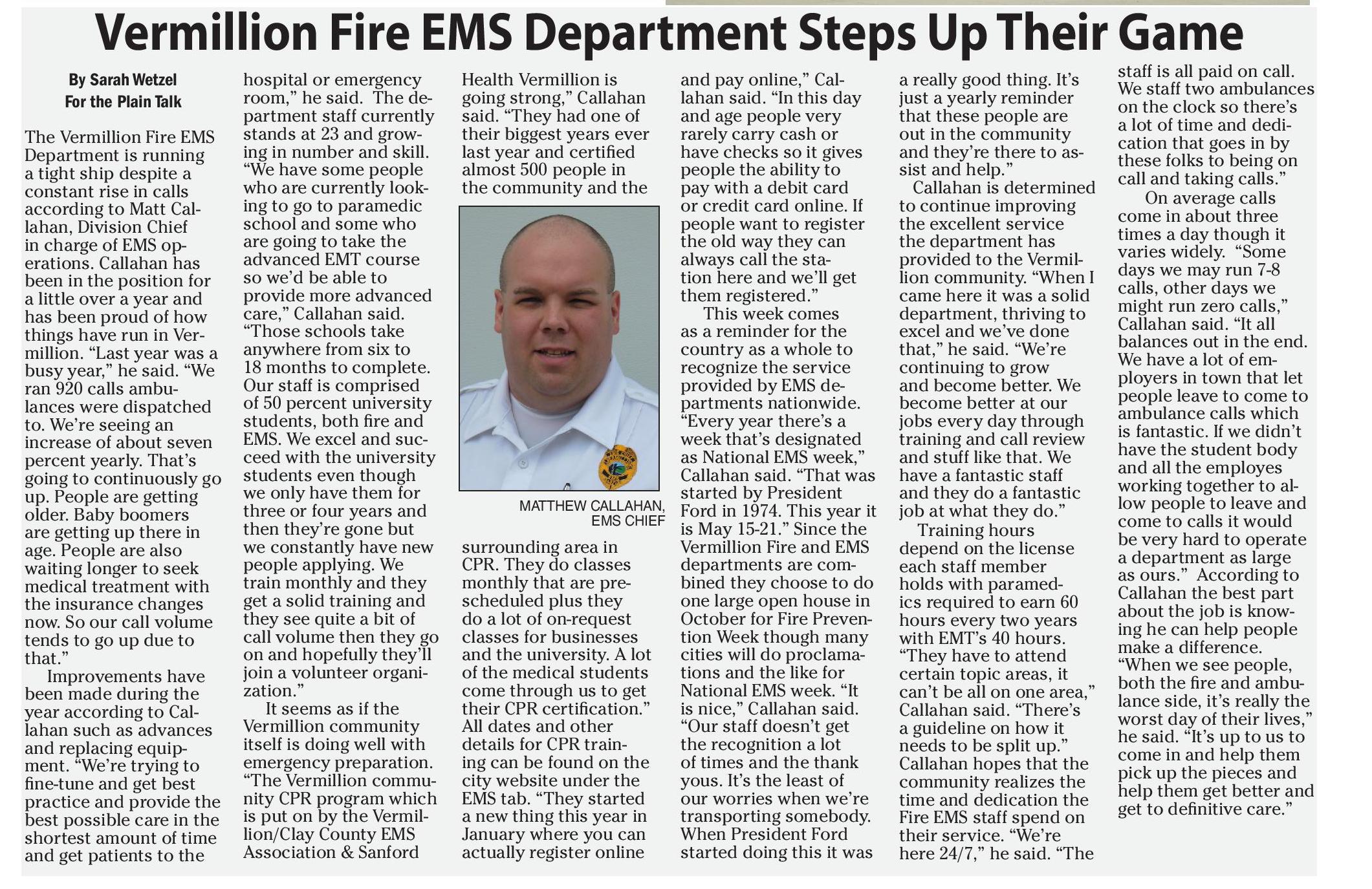



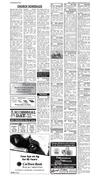






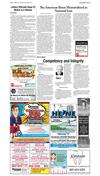
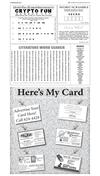
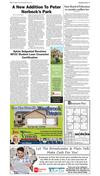

 Previous Page
Previous Page






